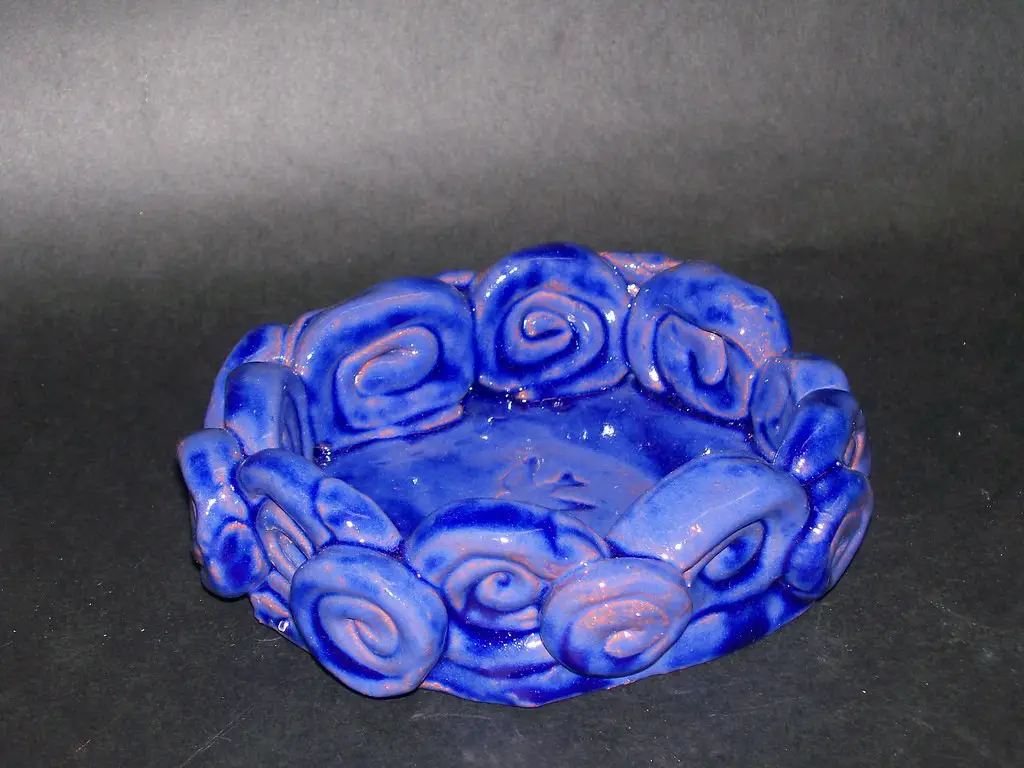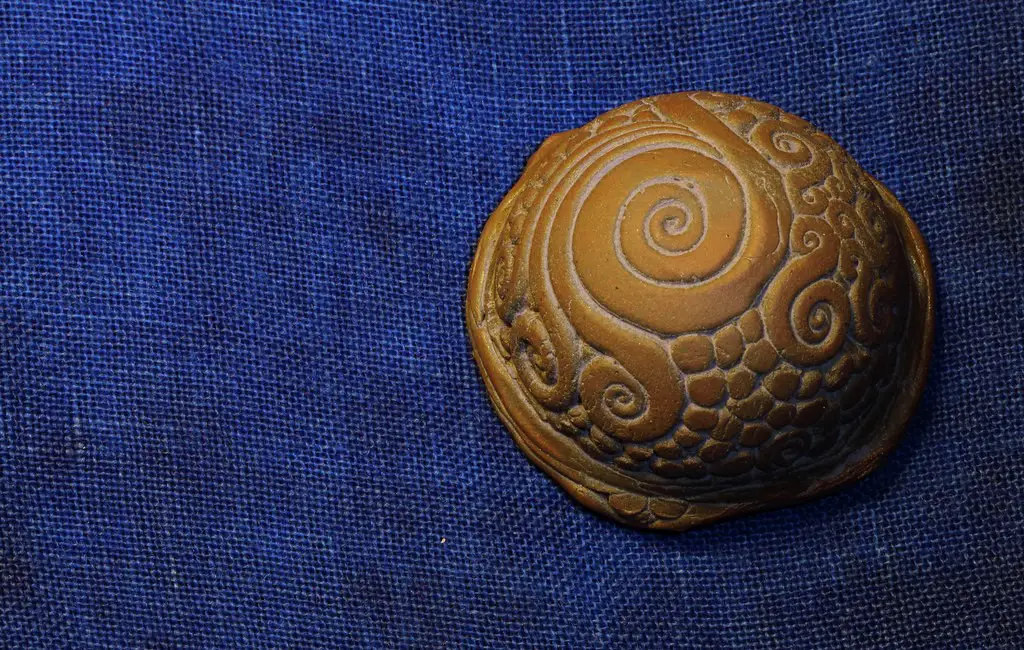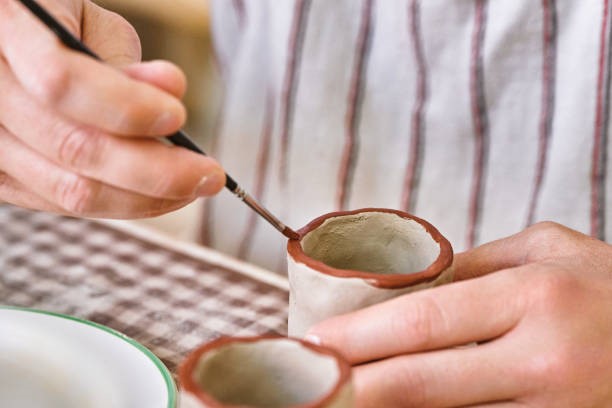Before beginning your coil pottery project, ensure you have all the necessary ingredients and tools. The materials needed are clay, water, slip, a wooden board, and covering cloth/plastic. A rolling pin, clay cutting wire, rib tool, sponge, needle tool, modeling tools, paint brushes, and a kiln are all necessary. To set up your workplace, select a level surface, grab your protective equipment, and wedge the clay. Making a coil pot entails rolling coils, forming a base, coiling, smoothing, shaping, decorating, drying, firing, and adding finishing touches to complete your masterpiece. Keep reading to learn the whole process in detail!
What are the Key Materials Needed to Make a Coil Pot?
Ensure you have your materials before working on your coil pottery. You will need certain materials to make coil pots. The table given below discusses these materials in detail.
| Materials | Purpose |
| Clay | Clay is the essential ingredient required to make coil pottery. Choose a clay body that fits your project, such as earthenware, stoneware, or porcelain. Each variety of clay has unique characteristics and firing temperatures. |
| Water | Water is necessary to keep the clay moist and workable. Use water carefully to keep the clay from becoming too wet or sticky. |
| Slip | Slip is a clay-water mixture that serves as a glue for joining coils. It helps to connect the clay pieces and form a sturdy structure. |
| Wooden Board | A wooden board or canvas offers a flat and smooth surface for working with clay. It’s where you’ll roll out your clay and make coil pots. |
| Cloth or Plastic | Covering your work surface with cloth or plastic prevents clay from clinging to it and makes cleanup easier. |
Tools Required to Aid the Coil Pottery Process
Now that you know the materials used to make coil pots, let’s learn about the tools needed. The following table lists all the necessary tools and their significance in coil pottery making.
| Tools | How Do They Help? |
| Rolling Pin | A rolling pin is essential for coil pottery because it flattens and smoothens the clay before shaping it into coils. Using a rolling pin, you can obtain equal thickness throughout the clay, resulting in consistent coil pots. This tool helps to uniformly spread the clay, making it easier to work with and preventing uneven surfaces in finished sculptures. |
| Clay Cutting Wire | The clay cutting wire is essential for neatly and precisely cutting clay. Its thin wire stretched between two handles separates clay particles without changing shape. This tool is handy for cutting huge clay slabs into smaller pieces for coil-making or other pottery processes. |
| Rib Tool | A rib tool is a flat, smooth tool used for refining and smoothing the surface of clay. It contributes to clean lines and soft edges on your coil pots, producing a professional and polished appearance. The rib tool is handy for smoothing defects and integrating seams between coils, resulting in a seamless appearance in your finished ceramic pieces. |
| Sponge | Sponges are vital for keeping your hands moist when dealing with clay. They also smooth off rough places and merge seams between coils, resulting in a consistent and well-finished surface on your coil pots. |
| Needle Tool | Needle tools, often known as toothpicks, are versatile tools for scoring the surface of clay, creating roughness, and making beautiful patterns. They’re also helpful for penetrating air bubbles. |
| Modeling Tools | Modeling tools come in various forms and sizes, providing versatility when molding and sculpting clay. They help you to add precise features and adjust the shape of your coil pots, giving depth and character to your final products. |
| Paintbrushes | Paintbrushes are essential for applying slip, glazes, and ornamental finishes to coil pots. A soft-bristled brush provides a smooth application and precise details on your clay creations. |
| Kiln | A kiln is a necessary instrument for firing coil pottery. It heats the clay at a high temperature, causing it to solidify and become more durable. Use the required fire temperatures for your chosen clay type to attain the desired results in your coil pottery projects. |
How to Prepare the Workspace?
First, create a comfortable and efficient environment to prepare your workplace for coil pottery. Choose a level and solid surface, such as a sturdy table or workbench. Ensure the environment is well-ventilated to avoid inhaling clay dust and fumes throughout the pottery process.
Gather the correct gear to protect your safety when dealing with clay. Wear an apron or old clothes to avoid clay stains and splatters. Consider using gloves to protect your hands from prolonged exposure to clay, which can cause dryness or discomfort.
Before you begin working with clay, you must prepare it for use. Wedging the clay removes air bubbles and ensures a uniform consistency. Wedging also includes frequently kneading the clay to increase its plasticity and workability. To wedge clay efficiently, place it on a clean, flat surface and use your heel to press it down and away from you. Then, fold the clay in half and repeat numerous times until it is smooth and free of air pockets.
Next, divide the clay into manageable sections according to the size and shape of your coil pottery project. Use a wire tool or cutter to separate the clay into working bits properly. Remember that working with smaller portions of clay makes it easier to control the shape of your coil pots.
After preparing the clay, cover any unused pieces with plastic wrap or a damp towel to keep them from drying out while you work. It helps to keep the clay moist and prevents it from becoming stiff or unusable.
How to Make a Coil Pot?

Coil pot making is a simple yet beautiful activity. It allows you to create unique and expressive works that represent your creativity. Here’s a step-by-step guide to making a coil pot:
1. Rolling Coils
Rolling coils is the primary method that forms the foundation of coil pottery. Clay is shaped into long, consistent coils, which then get used to build the pot’s walls. Roll some clay between your palms to form coils of constant thickness and smooth texture. Ensuring that the coils are the same thickness and devoid of air bubbles or abnormalities is essential.
Adjust the coil length and thickness to suit your design preferences and the pot size you wish to make. Longer coils are appropriate for larger pots, and shorter coils are great for smaller ones. Experiment with various coil lengths and thicknesses to achieve the desired aesthetic and structural result.
2. Creating the Base
To build a coil pot, first prepare your coils. Then, create the base. Take one coil end and form it into a flat disk or circular. Press the disk firmly onto a smooth surface to maintain stability and evenness. The base provides a solid foundation for the walls of your pot.
3. Coiling
Once the base is ready, start coiling the clay around its perimeter. Take another coil of clay and carefully push it against the base’s edge, ensuring it adheres firmly. Continue layering coils to build up the walls of your pot gradually. Experiment with varied coil locations and angles to create unique forms and curves in your pottery.
Pay attention to how the coils are arranged and smooth as you coil the clay. Smooth any seams or inconsistencies between the coils with your fingers, a rib tool, or a sponge. Proper smoothing guarantees that the pot’s surface is consistent and free of cracks and flaws.
4. Smoothening
While coiling the clay, smooth out the seams between each coil. To achieve a consistent surface, merge the coils flawlessly using your fingers, a rib tool, or a sponge. Smoothing the clay helps prevent cracks and irregularities while the pot dries and is fired in the kiln.
5. Shaping
Once you’ve reached the required height for your pot’s walls, it’s time to experiment with other shapes. Shape the clay into various shapes and structures using your hands, pottery tools, or household items. Experiment with curves, angles, and textures to give your pot more visual interest and dimension. Adjust the pot’s shape and surface, paying particular attention to rim thickness and overall symmetry. Feel free to try different shaping methods and procedures for the desired results.
6. Decorating
Decorative embellishments are added at the end to improve the aesthetic appeal of a coil pot. Use tools such as needles, toothpicks, and stamps to create patterns, textures, or detailed designs on the clay’s surface. Experiment with different glazes, underglazes, and surface treatments to give your product more color, depth, and character. Texturing techniques enhance the depth, character, and visual attractiveness of your pottery pieces, helping you to create original and captivating designs. Here’s an overview of some popular texturing techniques and how you may use them to improve your pottery:
A. Carving and Sculpting
Carving is the process of cutting or incising patterns, shapes, or designs into the surface of clay with various tools such as knives, needles, and carving tools. To provide texture and visual contrast, you can carve elaborate patterns, geometric shapes, or organic themes into your pottery. Sculpting is shaping and bending clay with your hands or sculpting tools to incorporate three-dimensional features and sculptural details into your pieces. Using carving and sculpting techniques, you may create distinctive and expressive pottery designs that represent your artistic vision.
B. Painting and Glazing
Painting and glazing are different methods to add color, depth, and surface effects to your ceramics. Underglazes, oxides, or ceramic paints can paint complicated motifs, patterns, or images directly into the clay’s surface before burning. Experiment with brushstrokes, layering, and mixing to develop various visual effects and dramatic compositions. Glazing is putting a layer of glaze (a glass-like coating) on the surface of bisque-fired ceramics. Glazes come in multiple colors, textures, and finishes, allowing you to create glossy, matte, or textured surfaces. Experiment with glazing techniques such as dipping, pouring, spraying, and brushwork to produce unique and eye-catching ceramic pieces that exhibit your creativity and artistry.
7. Drying and Firing
Proper drying and firing are necessary in pottery-making to ensure your finished pieces’ strength, longevity, and integrity. After shaping, decorating, and texturing your pottery, let it dry completely in an excellent spot away from direct sunshine or heat sources. Slow, even drying helps to avoid cracking, warping, and other flaws during firing. When the pottery is dried, it is ready to be fired in a kiln, a high-temperature furnace that hardens and vitrifies clay. The firing process entails heating the pottery to precise temperatures based on the clay and glaze. The clay undergoes chemical and physical changes during a fire, changing into a long-lasting ceramic material. After firing, let the pottery cool slowly before handling.
8. Finishing Touches
Once you’ve finished your pottery piece’s main body and decoration, it’s time to add the final touches. This stage involves perfecting the surface, correcting flaws, and preparing the sculpture for its final display. It’s like adding the finishing touch to make everything look polished and complete. You can do the following things to make sure your coil pot is perfect:
A. Fixing Cracks and Warps
Cracks and warps are common issues that occur during the drying and fire stages of pottery making. Cracks can appear due to uneven drying or stress within the clay. To repair cracks, carefully soften the affected region with water and apply a thin, wet clay or slip layer. Then, carefully smooth off the surface so the patch blends perfectly with the rest of the pottery. Warps, on the other hand, form when the clay changes shape when drying or firing. You can carefully reshape the sculpture flexibly or use extra clay to fill in bent sections.
B. Fixing Uneven Texture
The uneven texture might reduce the overall appearance of your pottery. There are various options for addressing rough or uneven spots on the surface. To get a uniform finish, carefully smooth off the texture using a rib tool or sponge. Take your time and be patient, focusing on removing any bumps or irregularities. The idea is to provide an appealing tactile feel that encourages touch and admiration. There are various sponges available in the market that can help you fix the cracks in the coil pot. However, the YFDB Store’s Pottery Sponge is among the best sponges available.
Conclusion
Coil pot making is an exciting and creative activity. It requires specific materials and tools and follows a step-by-step process, from preparing the workspace to firing the coil pot. Artists who want to express themselves further can add decorative touches and fix the cracks and dents caused by the firing for a polished look.








